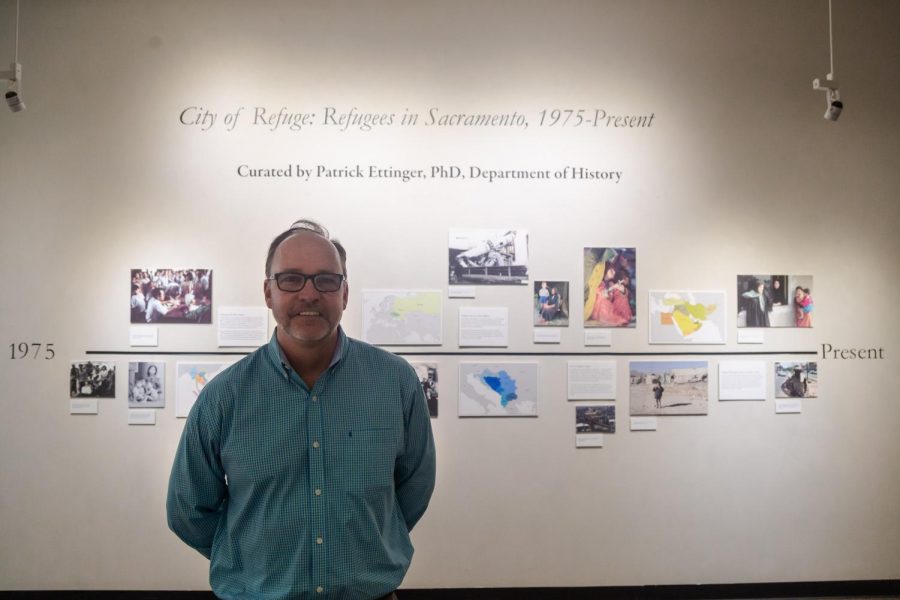Sac State library exhibit showcases Sacramento refugee statistics
Exhibit includes timeline of refugee population and migration patterns
Eucario Calderon – State Hornet
Patrick Ettinger, professor and director of the the public history program at Sac State, is the curator for the refugee gallery that will be on display in Sac State’s library exhibit from April 9 – 26.
May 6, 2019
An exhibit featuring the history and experiences of refugees from across the world who made Sacramento their home was on display at the University Library Gallery throughout April.
The exhibit, titled “City Of Refuge: Refugees in Sacramento, 1975 – present,” covered the history of Sacramento’s refugee population spanning from 1975 to present day.
The gallery included the history of different groups’ immigration to Sacramento, a timeline of events that led people to flee their homelands for new beginnings and personal stories from immigrants including personal belongings like photos, documents and family heirlooms.
Students had the opportunity to see items from all over the world like clothing from Southeast Asia, bags handmade from a fishing line by a Vietnamese refugee living in a camp and photo albums from a family that fled from Bosnia.
“What really stood out to me is all the memorabilia and the history attached to these items,” said Jordan Siangco, a fine arts major at Sac State. “I think this exhibit shows just how diverse this city is. People come from all types of backgrounds, and it’s nice to see people’s individual stories and how it all led to coming to this city.”
According to Patrick Ettinger, professor and director of the Public History Program, his goal in organizing the exhibit was for visitors to learn the history of the refugee families that arrived in Sacramento and the role they played in shaping the city’s diverse culture.
“The idea here is for people to understand just how centrally important refugees are to Sacramento’s history,” Ettinger said. “I wanted people to come here and say ‘Not only do I understand there are a lot of refugees in this community, now I understand why they are here.’”
One aspect of the exhibit Ettinger made sure to point out was the oral histories and interviews of refugees that were forced to leave their home countries such as Vietnam, Laos Iraq, Bosnia and Russia.
These oral histories shared their experiences of leaving their homeland, and the struggle of living through refugee camps and settling in Sacramento.
“As a historian, I think things work best for people when they can recognize the humanity of the people,” Ettinger said.
The exhibit also incorporated charts that provided context about refugee arrivals in the United States, as well.
One chart showed the number of refugees arriving in the United States by year and information such as the standing president at the time of their arrival, significant historical events taking place and the regions the refugees came from.
Another chart had the top 20 cities based on the number of refugees that settled there from 1983 to 2004. Sacramento ranked 10th on the list with 37,436 refugees.
Mechanical engineering major student CJ David said he was surprised by some of the facts he learned from the exhibit.
“Before coming in here, I didn’t know that a lot of refugees were coming into Sacramento specifically,” David said. “It’s important for people to know this history because it helps us better understand Sacramento’s history as a whole.”
Ettinger said he hopes historical exhibits like his will become more common at Sac State.
“It’s just another way for people to learn about aspects of the past,” Ettinger said. “I am going to continue to work and do research that relate to the history of refugees. It’s going to continue to be a subject for me whether or not that ends up being another exhibit.”





























































































































